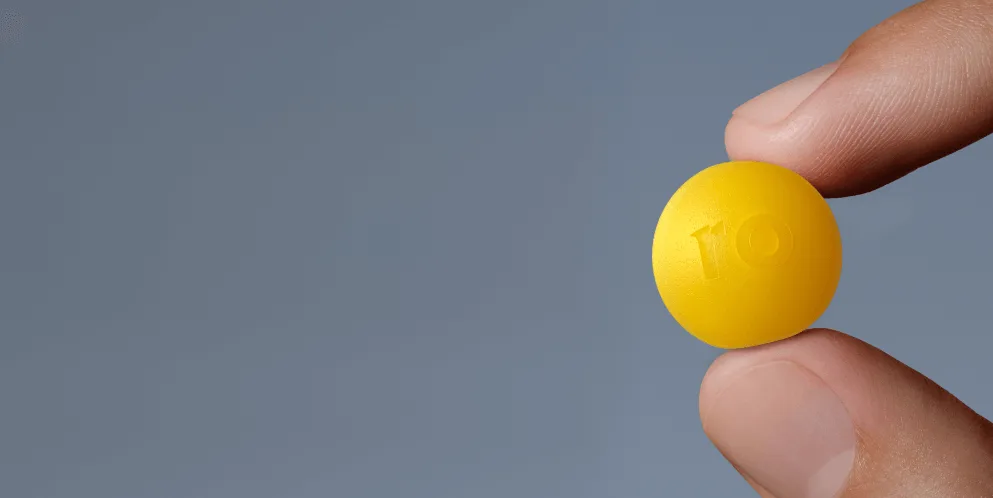Key takeaways
Yes, an enlarged prostate can affect a man sexually because it can cause pain, reduce libido, and result in urinary issues that interfere with intimacy.
An enlarged prostate doesn’t directly cause ED, but both conditions become more common with age and often occur together.
Treatment of ED and sexual issues related to an enlarged prostate can include prescription medications, lifestyle changes, and mental health support to address both physical and emotional impacts.
Here's what we'll cover
Here's what we'll cover
Here's what we'll cover
Key takeaways
Yes, an enlarged prostate can affect a man sexually because it can cause pain, reduce libido, and result in urinary issues that interfere with intimacy.
An enlarged prostate doesn’t directly cause ED, but both conditions become more common with age and often occur together.
Treatment of ED and sexual issues related to an enlarged prostate can include prescription medications, lifestyle changes, and mental health support to address both physical and emotional impacts.
An enlarged prostate and erectile dysfunction (ED) often go hand in hand. After all, they are both more likely to occur as you get older. But the question still remains: does an enlarged prostate affect a man sexually?
Ahead, we dig deeper into the relationship between prostate issues and ED and explain whether an enlarged prostate can cause ED as well as other penile issues.
3 ways an enlarged prostate can affect a man sexually
There are a few ways an enlarged prostate can affect sexual function. Benign prostatic hyperplasia (BPH) is a condition where the prostate enlarges or gets bigger and usually happens as you get older. This can cause sexual problems for men for several reasons.
1. Pain and discomfort
Inflammation linked to benign prostatic hyperplasia (BPH) can contribute to sexual problems. BPH may occur alongside prostatitis, a condition that causes prostate inflammation and swelling.
When inflammation and pelvic pain are present, they can interfere with sexual function and satisfaction. A 2011 study found that this prostatitis pain is associated with sexual dysfunction.
2. Decreased libido
Some medications used to treat BPH can affect your sex life.
A class of medications known as 5-alpha reductase inhibitors (aka 5-AR inhibitors) works by reducing the conversion of testosterone into dihydrotestosterone (DHT). This effect can lower your libido (sex drive).
If you have BPH or lower urinary tract symptoms, you could also have trouble ejaculating when taking 5-AR inhibitors. Why? Researchers are still trying to figure that out.
3. Urinary problems
As mentioned above, BPH can cause urinary problems, such as urinary tract infections. These lower urinary tract symptoms (LUTS) are also associated with erectile dysfunction.
BPH can also cause you to feel like you need to pee (urinary urgency). And this urgency can be uncomfortable (as anyone who’s been stuck on the road with a full bladder and no rest stop in sight knows).
So, when you’re dealing with this gotta-go-pressure, you might be too distracted by your urethra to want to have sex.
Can an enlarged prostate cause ED?
While experts don’t know for sure if an enlarged prostate can directly cause ED, there is a link between the two.
BPH is a common age-related condition in which the prostate enlarges, though it doesn’t affect every man.
Here’s what the science has to say about the association between an enlarged prostate and ED:
A 2020 scientific review suggests that BPH and related lower urinary tract symptoms are “closely related” to the “decline of erectile function.”
A 2013 study found ED to be a possible side effect of 5-AR inhibitors, a class of medications to treat BPH.
A 2019 review indicated that transurethral resection of the prostate (TURP) has been linked to increased risk of ejaculatory dysfunction, particularly retrograde ejaculation.
A 2016 review showed that up to 85% of men who have had their entire prostate removed experience problems with erections post-surgery.
A 2011 study indicated pain from prostatitis — inflammation of the prostate — can lead to sexual dysfunction.
Can an enlarged prostate keep you from ejaculation?
Yes, an enlarged prostate may cause other sexual problems, including trouble ejaculating.
One study found that almost half of patients with BPH and lower urinary tract symptoms (LUTS) experience difficulty with ejaculation. But researchers don’t really fully understand why this can happen.
Some of the treatments for an enlarged prostate might also be to blame for ejaculation issues.
Proscar (finasteride): Proscar is a prescription medication for BPH that lowers levels of DHT, a hormone involved in prostate growth and the production of some components of ejaculatory fluid. When DHT levels drop, the prostate may produce less fluid, which can result in reduced ejaculate volume. This can also cause the mechanics of ejaculation to feel weaker or “off.” In fact, decreased volume of ejaculation and ejaculation disorders are both listed as common side effects in this drug’s prescribing information.
Transurethral resection of the prostate (TURP): A common side effect of TURP surgery is a “dry orgasm” or “dry climax,” also known as retrograde ejaculation. Instead of semen exiting the penis, it flows backward into the bladder. This can happen if the muscles at the bladder opening don’t fully close after surgery. While this doesn’t prevent your ability to orgasm, it can be an issue if you are trying to get pregnant, since semen isn’t making its way out.
3 ways to treat ED or sexual issues from an enlarged prostate
As if dealing with an enlarged prostate wasn’t already enough, adding ED into the mix can be, well, a lot. The good news? There are several things you can do, including taking medication and changing your lifestyle, to help with such sexual issues.
1. Prescription ED medication
Treating ED often begins with prescription medications, most commonly those from a class of drugs called phosphodiesterase type 5 (PDE5) inhibitors.
PDE5 inhibitors work by increasing blood flow to the penis during arousal to give you harder erections. They include:
Cialis (tadalafil), which is also approved to treat BPH when taken at a low dose on a daily basis
Stendra (avanafil)
Certain PDE5 inhibitors can also be found in non-pill formulations, such as:
Ro Sparks, a lozenge that dissolves under the tongue and contains both tadalafil and sildenafil (the active ingredients in Cialis and Viagra, respectively) to deliver fast-acting ED treatment
Daily Rise Gummies, fruit-flavored gummies that contain tadalafil and are designed for daily use (and, thus, allow for increased spontaneity)
Keep in mind that these last two formulations have not been specifically FDA-approved for ED, though they do contain individual ingredients that have been FDA approved for ED treatment.
2. Lifestyle changes
Making changes to your lifestyle can help improve ED symptoms and overall sexual health naturally. Depending on the severity of your condition and other factors, a healthcare provider may recommend these strategies solo or in addition to other treatments like Rx meds.
Sexual health-promoting practices include:
Exercising regularly. Staying active on a regular basis is great for your heart, and a healthy ticker means better blood flow and pressure. Both of these effects can make it easier to get and keep an erection.
Following a healthy, balanced diet. What you eat can play a big role in lowering your risk of high blood pressure, type 2 diabetes, and obesity, all of which have been linked to ED. Aim for plenty of fruits, veggies, whole grains, and lean proteins, and keep processed foods, added sugars, and extra sodium to a minimum.
Getting good, quality sleep. Poor shut-eye can not only lead to ED, but it can also contribute to obesity, high blood pressure, heart disease, and type 2 diabetes — conditions that affect blood flow and, thus, your erections. Try building healthier sleep habits and going to bed earlier to reach that 7–9 hour sweet spot.
Quitting smoking. Research shows that smokers face about a 50% higher risk of ED than people who don’t smoke. The good news is that quitting can lead to noticeable improvements in erections and overall sexual well-being over time.
Limiting (or cutting out) alcohol. Heavy drinking is tied to higher rates of erection issues, likely due to the long-term effects of alcohol on blood vessels and other key body functions. If you regularly have more than two drinks per day, cutting back on alcohol (or stopping altogether) may help improve erections and support overall health.
3. Mental health support
Besides being a physical condition, ED can also be caused by stress and anxiety. And that stress can feed right back into worsening symptoms.
To ease your mind and improve your psyche, practice regular stress management. Techniques include:
And if you feel like you could use a bit more help, don’t be afraid to consult a mental health professional, such as a licensed therapist.
Bottom line
We started off with the question, “Does an enlarged prostate affect a man sexually?” And by now, you (hopefully!) understand that the answer is “yes, it can.” But we covered a lot, so let’s do a quick run-through of what to remember:
Research shows that there’s a clear link between an enlarged prostate and ED. While a strong correlation exists and some treatments may help with both conditions, researchers have not yet determined that an enlarged prostate directly causes ED.
Some medications used to treat BPH may cause ejaculation problems. For example, 5-AR inhibitors like Proscar help treat an enlarged prostate. But they may also cause problems with ejaculation in some men.
ED issues from an enlarged prostate can be treated in various ways. Prescription medications like PDE5 inhibitors (e.g. Viagra, Cialis) are common first-line treatments for ED. Lifestyle changes (e.g. getting regular exercise, eating a healthy diet) and taking care of your mental health can also help manage sexual symptoms.
Talk with your healthcare provider. If you’re experiencing symptoms of an enlarged prostate (such as urinary troubles), dealing with sexual dysfunction, or both, consult a healthcare provider. They can help you determine what might actually be causing your symptoms and develop a treatment plan to support your overall (and sexual!) health.
Frequently asked questions (FAQs)
What is the fastest way to shrink an enlarged prostate naturally?
No one way will shrink an enlarged prostate immediately. That being said, lifestyle changes, such as eating a healthy diet, quitting smoking, and getting regular exercise, can help improve prostate health naturally and help you manage symptoms over time. You can also ease discomfort by limiting fluids before bed and urinating when you feel the urge rather than holding it in.
Can you live a long life with an enlarged prostate?
Yes, you can live a long life with an enlarged prostate (benign prostate hyperplasia or BPH). BPH is not cancerous, and it doesn’t increase your risk of prostate cancer. However, if left untreated, it can lead to complications such as urinary tract infections and, in severe cases, kidney damage. Talking with a healthcare provider about your symptoms and following a recommended treatment plan can help manage BPH and reduce the risk of complications.
Can you take Viagra if you have an enlarged prostate?
Yes, you can take Viagra if you have an enlarged prostate, according to Viagra’s prescribing information. In fact, Cialis, a medication that works similarly to Viagra, is FDA-approved to treat both erectile dysfunction and the urinary symptoms of BPH when taken at a low dose on a daily basis.
Does an enlarged prostate mean more pleasure?
No, an enlarged prostate doesn’t necessarily give you more pleasure. In fact, it might cause pain or discomfort after ejaculation, especially if you also have prostatitis.
Does ejaculating help an enlarged prostate?
No, ejaculating doesn’t help shrink an enlarged prostate. But some people may have trouble ejaculating if they have an enlarged prostate. Often, this is due to the medications used to treat the condition.
DISCLAIMER
If you have any medical questions or concerns, please talk to your healthcare provider. The articles on Health Guide are underpinned by peer-reviewed research and information drawn from medical societies and governmental agencies. However, they are not a substitute for professional medical advice, diagnosis, or treatment.
Viagra Important Safety Information: Read more about serious warnings and safety info.
Cialis Important Safety Information: Read more about serious warnings and safety info.
References
Allen, M. S., Wood, A. M., & Sheffield, D. (2023). The Psychology of Erectile Dysfunction. Current Directions in Psychological Science, 32(6), 487-493. doi: 10.1177/09637214231192269. Retrieved from https://journals.sagepub.com/doi/full/10.1177/09637214231192269
Anawalt, B. D. (2017). Is Dihydrotestosterone a Classic Hormone? Endocrine Reviews, 38(3), 170-172. doi: 10.1210/er.2017-00091. Retrieved from https://academic.oup.com/edrv/article/38/3/170/3861397
Bilal, A. & Abbasi, H. (2020). Cognitive Behavioral Sex Therapy: An Emerging Treatment Option for Nonorganic Erectile Dysfunction in Young Men: A Feasibility Pilot Study. Sexual Medicine, 8(3), 396. doi: 10.1016/j.esxm.2020.05.005. Retrieved from https://pmc.ncbi.nlm.nih.gov/articles/PMC7471093/
Canguven, O. & Burnett, A. L. (2008). The effect of 5 alpha-reductase inhibitors on erectile function. Journal of Andrology, 29(5), 514–523. https://doi.org/10.2164/jandrol.108.005025. Retrieved from https://onlinelibrary.wiley.com/doi/full/10.2164/jandrol.108.005025
Cao, S., Yin, X., Wang, Y., et al. (2013). Smoking and risk of erectile dysfunction: systematic review of observational studies with meta-analysis. PloS One, 8(4), e60443. doi: 10.1371/journal.pone.0060443. Retrieved from https://pmc.ncbi.nlm.nih.gov/articles/PMC3616119/
Cho, J. W. & Duffy, J. F. (2019). Sleep, Sleep Disorders, and Sexual Dysfunction. The World Journal of Men's Health, 37(3), 261–275. doi: 10.5534/wjmh.180045. Retrieved from https://www.ncbi.nlm.nih.gov/pmc/articles/PMC6704301/
Couteau, N., Duquesne, I., Frédéric, P., et al. (2021). Ejaculations and benign prostatic hyperplasia: An impossible compromise? A comprehensive review. Journal of Clinical Medicine, 10(24), 5788. doi: 10.3390/jcm10245788. Retrieved from https://www.ncbi.nlm.nih.gov/pmc/articles/PMC8704358/
Das, A. K., Leong, J. Y., & Roehrborn, C. G. (2019). Office-based therapies for benign prostatic hyperplasia: a review and update. Canadian Journal of Urology, 26(4), 2-7. Retrieved from https://pubmed.ncbi.nlm.nih.gov/31481142/
Duca, Y., Calogero, A. E., & Cannarella, R., et al. (2019). Erectile dysfunction, physical activity and physical exercise: Recommendations for clinical practice. Andrologia, 51(5), e13264. doi:10.1111/and.13264. Retrieved from https://pubmed.ncbi.nlm.nih.gov/30873650/
Emanu, J. C., Avildsen, I. K., & Nelson, C. J. (2016). Erectile dysfunction after radical prostatectomy: prevalence, medical treatments, and psychosocial interventions. Current Opinion in Supportive and Palliative Care, 10(1), 102–107. doi: 10.1097/SPC.0000000000000195. Retrieved from https://www.ncbi.nlm.nih.gov/pmc/articles/PMC5005072/
Foster, H. E., Dahm, P., Kohler, T. S., et al. (2019). Surgical Management of Lower Urinary Tract Symptoms Attributed to Benign Prostatic Hyperplasia: AUA Guideline Amendment 2019. Journal of Urology, 202(3), 592-598. doi: 10.1097/JU.0000000000000319. Retrieved from https://pubmed.ncbi.nlm.nih.gov/31059668/
Franco, J. V., Turk, T., Jung, J. H., et al. (2018). Non-pharmacological interventions for treating chronic prostatitis/chronic pelvic pain syndrome. The Cochrane Database of Systematic Reviews, 12(5), CD012551. doi: 10.1002/14651858.CD012551.pub3. Retrieved from https://pubmed.ncbi.nlm.nih.gov/29757454/
Gandhi, J., Weissbart, S. J., Smith, N. L., et al. (2017). The impact and management of sexual dysfunction secondary to pharmacological therapy of benign prostatic hyperplasia. Translational Andrology and Urology, 6(2), 295-304. doi: 10.21037/tau.2017.03.57. Retrieved from https://www.ncbi.nlm.nih.gov/pmc/articles/PMC5422692/
Jacobsen, S. J., Jacobson, D. J., & Rohe, D. E., et al. (2003). Frequency of sexual activity and prostatic health: fact or fairy tale?. Urology, 61(2), 348–353. doi: 10.1016/s0090-4295(02)02265-3. Retrieved from https://pubmed.ncbi.nlm.nih.gov/12597946/
Kim, S. W. (2011). Prostatic disease and sexual dysfunction. Korean Journal of Urology, 52(6), 373–378. doi: 10.4111/kju.2011.52.6.373. Retreived from https://www.ncbi.nlm.nih.gov/pmc/articles/PMC3123811/
Ko, W. J., Han, H. H., Ham, W. K., & Lee, H. W. (2017). Daily use of sildenafil 50mg at night effectively ameliorates nocturia in patients with lower urinary tract symptoms associated with benign prostatic hyperplasia: an exploratory multicenter, double-blind, randomized, placebo-controlled study. The Aging Male, 20(2), 81-88. doi: 10.1080/13685538.2016.1204290. Retrieved from https://pubmed.ncbi.nlm.nih.gov/28590828/.
Krieger, J. N., Lee, S. W., Jeon, J., et al. (2008). Epidemiology of prostatitis. International Journal of Antimicrobial Agents, 31 Suppl 1(Suppl 1), S85–S90. doi: 10.1016/j.ijantimicag.2007.08.028. Retrieved from https://www.ncbi.nlm.nih.gov/pmc/articles/PMC2292121/
Ma, C., Su, H., & Li, H. (2020). Global research trends on prostate diseases and erectile dysfunction: A bibliometric and visualized study. Frontiers in Oncology, 10, 627891. doi: 10.3389/fonc.2020.627891. Retrieved from https://www.ncbi.nlm.nih.gov/pmc/articles/PMC7908828/
Mollaioli, D., Ciocca, G., & Limoncin, E., et al. (2020). Lifestyles and sexuality in men and women: the gender perspective in sexual medicine. Reproductive Biology and Endocrinology : RB&E, 18(1), 10. doi: 10.1186/s12958-019-0557-9. Retrieved from https://pubmed.ncbi.nlm.nih.gov/32066450/
Mysore, V. (2012). Finasteride and sexual side effects. Indian Dermatology Online Journal, 3(1), 62. doi: 10.4103/2229-5178.93496. Retrieved from https://pmc.ncbi.nlm.nih.gov/articles/PMC3481923/
Nagakura, Y., Hayashi, M., & Kajioka, S. (2022). Lifestyle habits to prevent the development of benign prostatic hyperplasia: Analysis of Japanese nationwide datasets. Prostate International, 10(4), 200. doi: 10.1016/j.prnil.2022.06.004. Retrieved from https://pmc.ncbi.nlm.nih.gov/articles/PMC9747574/
National Institute of Diabetes and Digestive and Kidney Diseases (NIDDK). (n.d.). Enlarged Prostate (BPH). Retrieved from https://medlineplus.gov/enlargedprostatebph.html
Ng, M., Leslie, S. W., & Baradhi, K. M. (2024). Benign Prostatic Hyperplasia. StatPearls. Retrieved from https://www.ncbi.nlm.nih.gov/books/NBK558920/
O'Leary, M. P. (2003). Lower urinary tract symptoms/benign prostatic hyperplasia: maintaining symptom control and reducing complications. Urology, 62(3 Suppl 1), 15–23. doi: 10.1016/s0090-4295(03)00480-1. Retrieved from https://pubmed.ncbi.nlm.nih.gov/12957196/
Russo, G. I., Bongiorno, D., Bonomo, C., et al. (2023). The relationship between the gut microbiota, benign prostatic hyperplasia, and erectile dysfunction. International Journal of Impotence Research, 35, 350-355. Retrieved from https://www.nature.com/articles/s41443-022-00569-1
Russo, G. I., Broggi, G., Cocci, A., et al. (2021). Relationship between dietary patterns with benign prostatic hyperplasia and erectile dysfunction: a collaborative review. Nutrients, 13(11), 4148. https://doi.org/10.3390/nu13114148. Retrieved from https://www.mdpi.com/2072-6643/13/11/4148
Silva, A. B., Sousa, N., Azevedo, L. F., & Martins, C. (2017). Physical activity and exercise for erectile dysfunction: systematic review and meta-analysis. British Journal of Sports Medicine, 51(19), 1419–1424. doi: 10.1136/bjsports-2016-096418. Retrieved from https://pubmed.ncbi.nlm.nih.gov/27707739/
Stratton, K. (2023). Enlarged prostate. National Library of Medicine. Retrieved from https://medlineplus.gov/ency/article/000381.htm
U.S. Food & Drug Administration (FDA). (2018). Highlights of Prescribing Information: Cialis (tadalafil) tablets, for oral use. Retrieved from https://www.accessdata.fda.gov/drugsatfda_docs/label/2018/021368s030lbl.pdf
U.S. Food and Drug Administration (FDA). (2023). Highlights of Prescribing Information: PROSCAR- finasteride tablet. Retrieved from https://nctr-crs.fda.gov/fdalabel/services/spl/set-ids/6f988153-fc74-4ca4-b29a-111f750c4a4b/spl-doc U.S. Food and Drug Administration (FDA). (2017). Highlights of Prescribing Information: VIAGRA (sildenafil citrate) tablets, for oral use. Retrieved from https://www.accessdata.fda.gov/drugsatfda_docs/label/2017/020895s048lbl.pdf
Zhang, F., Xiong, Y., & Qin, F., et al. (2022). Short Sleep Duration and Erectile Dysfunction: A Review of the Literature. Nature and Science of Sleep, 14, 1945. doi: 10.2147/NSS.S375571. Retrieved from https://pmc.ncbi.nlm.nih.gov/articles/PMC9621223/













